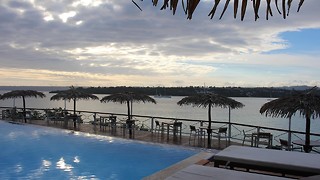Exhibition: Art and Power in Fiji
Chloe Clifford-Astbury is amazed by this comprehensive insight into Fijian history

Cambridge’s Museum of Archaeology and Anthropology has delved into its collection to produce Chiefs and Governors: Art and Power in Fiji, an exhibition remarkable not only for the beauty of the objects it displays, but also for the quality of information that accompanies them.
The museum’s first curator Baron Anatole von Hügel travelled within Fiji from 1874 to 1877 and assembled a spectacular collection of Fijian objects. When the museum opened in 1884, the material von Hügel had brought back from Fiji formed its founding ethnographic collection.
On entering the exhibition the visitor is greeted by a model Drua, a double-hulled canoe, a full-sized version of which was once presented to the wife of the Governor of Fiji in the 1870s. The boat has a house and platform perched on top of the deck, which is usually occupied by chiefs and their retinue.
The canoe sets the tone of the exhibition: a means of transport, but also a means of showing power. This idea, that to understand an object, we must understand not only how it is used but also what it means to the people who use it, seems central to the way the Museum organises its exhibitions.
This motif is seen repeatedly in the many splendid artefacts that follow. Weapons such as clubs and spears are of course used in warfare, but they are also symbols of power that are in general owned by chiefs and priests. Notable among these are the saisai, a spear composed of four heads bound to a central shaft, which hangs trident-like and fantastical above one of the display cases, and the vunikau, a deadly looking club with delicate whale ivory carvings worked into the nubs on its head. These weapons show status, but they also have spiritual meaning.
The sea is everywhere in this exhibition, and whale ivory, pearl shell and turtle shell ornament many of the objects. The Fijians did not hunt whales and this made whale ivory all the more precious – it was only obtained from beached animals, or from trade with the Tongans, and later the Europeans. Tabua, presentation whale teeth, were and are the most important of Fijian valuables. They are offered as gifts at important events, and also mark political alliances.
The arrival of the Europeans into the lives of the Fijians is marked by objects such as a whale-tooth necklace that has been bound in calico, a material considered valuable and desirable for its novelty and foreignness. Art and Power in Fiji is excellently curated, using objects to bring moments from Fiji’s pre and post-colonial history to the viewer. Visitors to the museum will not be disappointed.
 News / Academics lead campaign against Lord Browne Chancellor bid2 July 2025
News / Academics lead campaign against Lord Browne Chancellor bid2 July 2025 News / Lord Mandelson visits University30 June 2025
News / Lord Mandelson visits University30 June 2025 Features / 3am in Cambridge25 June 2025
Features / 3am in Cambridge25 June 2025 News / Clare students call on College to divest3 July 2025
News / Clare students call on College to divest3 July 2025 News / John’s students call on College to divest1 July 2025
News / John’s students call on College to divest1 July 2025








